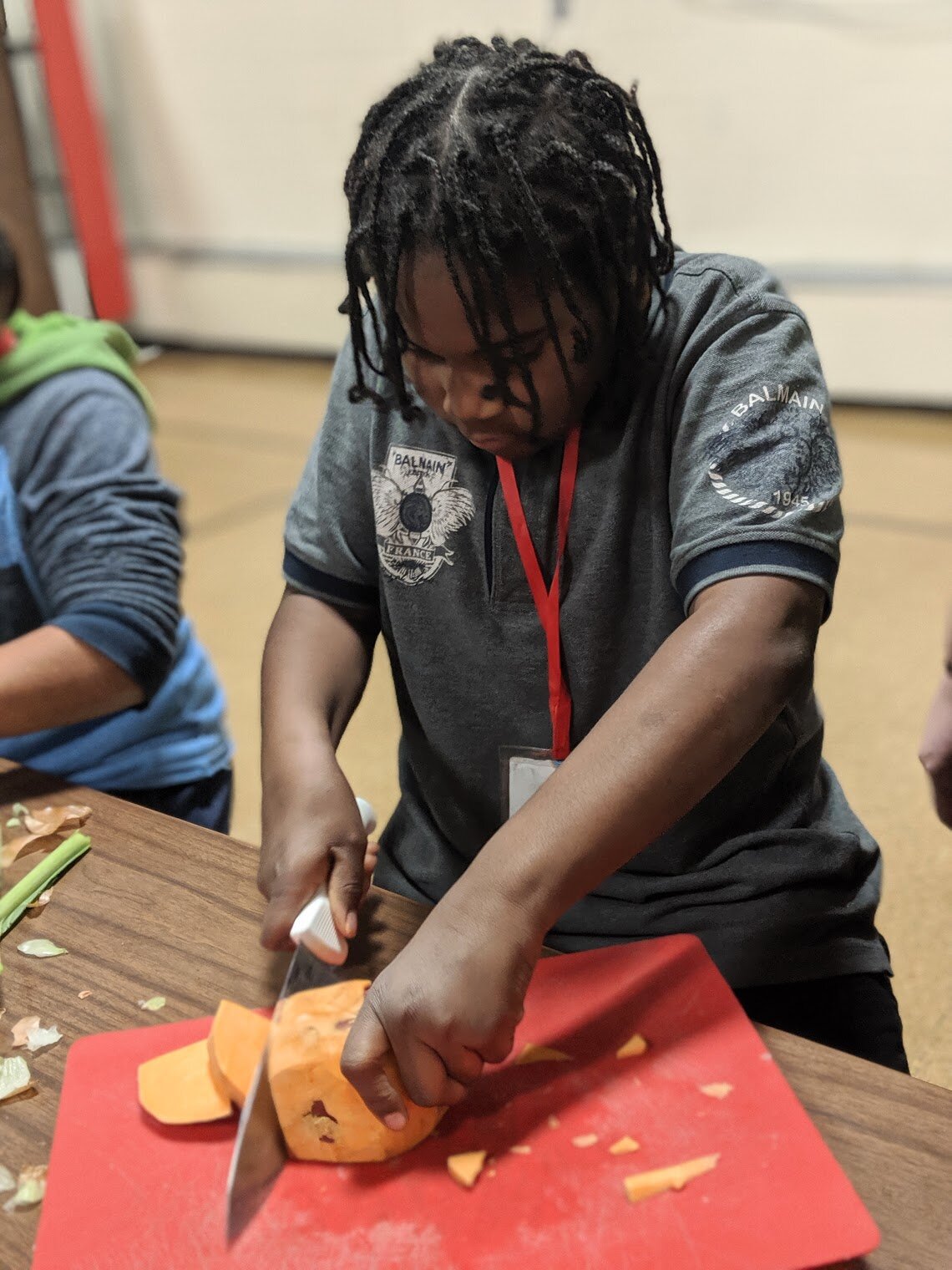Garden Club: Sweet Potato Soup
The first Garden Club of each month, students prepare a garden-inspired dish together. Almost always, they use vegetables and fruits directly from the garden that students harvested themselves.
The first Garden Club of November called for something warm: the Green Teens prepared a recipe card for Curried Sweet Potato soup. Having just hauled 50 pounds of Sweet Potatoes weeks earlier, the nutritious tuber was a natural choice to incorporate into a tasty soup.
The very first week of the summer Green Teens program, teens did a workshop on knife safety and how to use a chef’s knife properly. While there are “kid-safe” knives available, plastic ones with deeply serrated edges to avoid accidents, the team agreed it was important for kids to learn how to safely and appropriately use this key kitchen tool.
At the beginning of Garden Club, the teens offered several choices for activities for students. They had prepared a “Sweet Potato activity booklet,” complete with word-puzzles, maps showing the origin of a Sweet Potato, and in instructions on how to start sweet potato slips in water with toothpicks and a cup. The teens also prepared a station where students could start their own sweet potato slips to take home.
While several students started at the booklets, they quickly switched over to cooking.
After a quick demonstration and chat about knife safety by one of the Green Teens, each student chose a cutting board, chef’s knife, & piece of produce and got to work. Luckily, there were plenty of adults, so each student could almost be matched 1-to-1 with a grown-up. Some students got competitive and silly, showing just how quickly and skillfully they could finely chop cabbage leaves (even though adults emphasized that it was not a competition). Nearly all cooking in the garden is done with hand-drawn recipe sheets that use non-standard units of measurement. Instead of “a cup of spinach", the sheet will read “a handful or two of spinach.” We do this on purpose: Watch any skilled or experienced cook (or even just a grandma who loves to cook), you’ll notice that they cook intuitively most of the time. Nearly all soups have the same types of bases (onions, garlic, something acidic, something sweet). Nearly all basic salad dressings have similar ingredients or components (fat, acid, salt, and spices). By teaching students to cook intuitively (how much salt do you think we need? Let’s add a little and try it), they are also learning how play with proportions, use their sense of taste as a road map. After they get used to this way of cooking, the process feels much more playful and accessible.
After dicing onions, mincing garlic, harvesting fresh cabbage from the High Tunnel, cubing sweet potatoes, and pouring thick, rich coconut milk into the mixture, the soup was in the Instapot, ready to try for next garden club (alas, an hour and a half wasn’t enough time. Cooking always takes longer with little ones!). We were delighted that the students took cleaning up very seriously, sweeping the floor, wiping tables, and putting compost scraps in a bucket to be taken out to the garden. Though kids were disappointed we couldn’t try the soup that day, they had a blast cooking and cleaning together as a team.
Following each Garden Club, the team sits down and reflects together for 10-15 minutes about what went well, what could have gone better, what was surprising, what they learned, their favorite moment from garden club, how we could have improved planning, etc. This reflection piece is key to the process: learning is never-ending, and our team is strengthened by reflecting, disagreeing, and agreeing with each other.
Following this Garden Club, several team members said they felt frustrated when kids were cooking: it was hard to get their attention to show them how to cut something properly. Even though no one was hurt during the entire Club, some leaders felt anxious watching kids use knives, and were concerned about their maturity or ability to take knife safety seriously. This opened up a great conversation about how to use boundaries and natural consequences with children: You aren’t using knives safely, or treating it like a game? You have to take a break or find something else to do. It’s natural for kids to test boundaries and push buttons. By using natural consequences, students learn that they aren’t being “punished” because of vindictive reasons or because “we’re the boss,” but rather are being given boundaries so that they are safe.
The teens also noticed that, while several students were interested in the carefully-assembled booklets, they quickly switched to a cooking station. We discussed why this may have been: What was so appealing about the knives and cooking that wasn’t appealing about the booklets? They speculated that chopping and dicing with knives wasn’t something kids got to do very often, that books reminded them too much of school, and that cooking allowed students to use their bodies and hands differently than they normally do. Hands-on activities, like gardening or cooking, turned out to be consistently more appealing to kids than less hand-on stuff like reading books or doing worksheets.
By the end of the reflection time, everyone agreed that next time a cooking project happened (especially with knives), they would: 1) more carefully demonstrate with knives before passing them out, so kids were not distracted with them while trying to listen and 2) not bother creating other activities or stations on cooking days, as cooking was such a popular activity.



